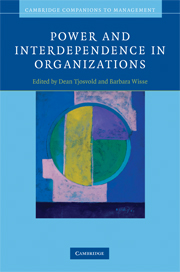Book contents
- Frontmatter
- Contents
- List of figures
- List of tables
- Foreword
- Introduction
- I Relationships to manage the faces of power
- II Participative leadership: Leading with others
- III Exchange dynamics and outcomes
- 9 Power and social exchange
- 10 The power process and emotion
- 11 Gender inequalities in power in organizations
- IV Power to influence
- V Leading with values
- Index
- References
10 - The power process and emotion
Published online by Cambridge University Press: 19 January 2010
- Frontmatter
- Contents
- List of figures
- List of tables
- Foreword
- Introduction
- I Relationships to manage the faces of power
- II Participative leadership: Leading with others
- III Exchange dynamics and outcomes
- 9 Power and social exchange
- 10 The power process and emotion
- 11 Gender inequalities in power in organizations
- IV Power to influence
- V Leading with values
- Index
- References
Summary
Introduction
Power is a crucial phenomenon in organizations, both pervasive and somewhat elusive. The study of power in organizations has a long tradition (Crozier 1964), yet the literature on power is fragmented and has been a central focus only intermittently over time. Fundamental assumptions about the role of power vary widely. On the one hand, power can be construed broadly as a negative and divisive force in relations, groups, and organizations. It enables those having power to exert influence over or command the compliance of others through coercion, force, and threats. This is the punitive, manipulative face of power (Deutsch and Krauss 1962; Lawler et al. 1988; Tedeschi et al. 1973). On the other hand, power can be construed as a positive, integrative force enabling those with power to provide rewards, inducements, and reinforcements to others (Bacharach and Lawler 1980; Boulding 1989). It gives those with power the opportunity to promote cooperation and collaboration. The negative view of power emphasizes the harm it can do and the resistance it can generate, whereas the positive view of power emphasizes the role of power in mobilizing concerted action toward collective goals. Implicitly, negative and positive emotions (e.g., pleasure, enthusiasm, pride or anger, fear, sadness) are likely to be associated, respectively, with the negative and positive faces of power. This chapter proposes a power-process model for examining the relationship between power and emotion.
- Type
- Chapter
- Information
- Power and Interdependence in Organizations , pp. 169 - 185Publisher: Cambridge University PressPrint publication year: 2009
References
- 2
- Cited by



